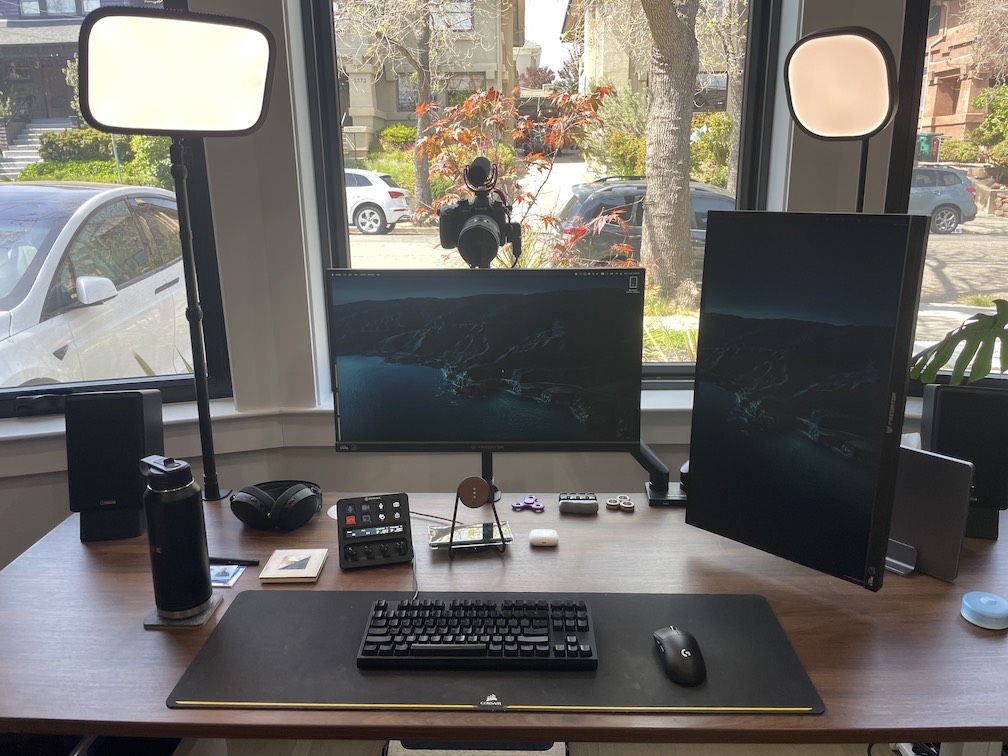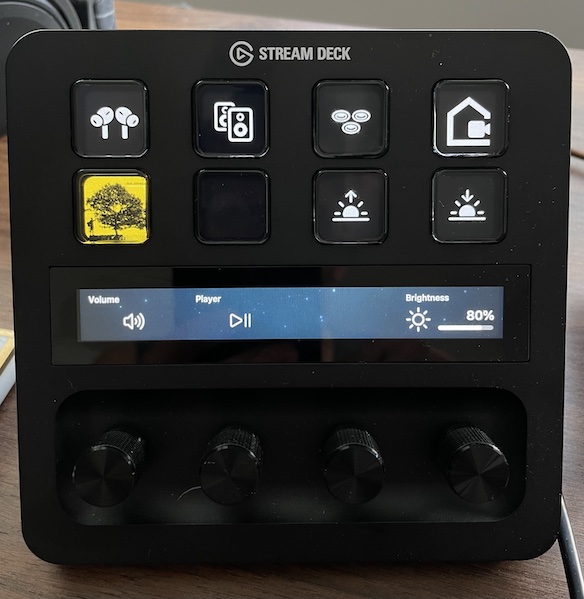Using AppleScript and Elgato Stream Deck to Toggle AirPlay Audio Output
Jesse Chen • April 29, 2023 • 4 min read

At work, we have a VC Perfectionist group where enthusiasts share their over-the-top video conferencing setup for others to emulate and admire. I have, unfortunately, gone off the deep end and have decided to sink excessive time and money to making the best setup possible.
One of the last nuisances with my VC setup is switching the audio output device between my AirPlay speakers and AirPods. In my case, I use my AirPods when I’m on VC and speakers otherwise. I find myself having to constantly go to the Sound settings to toggle between the two, and have decided it’s time to make this a one-button shortcut.
Setting up the AppleScript#
First step is to write the AppleScript to programmatically set your audio output to your specified device. At first, switchaudio-osx on GitHub looked to be the perfect solution. However, this did not work for my use case because my speakers are on AirPlay and it cannot detect AirPlay devices.
The only other alternative is to programmatically open the System Preferences window and use accessibility identifiers to select the output devices from the settings menu. With a bit of help from chatGPT, I took a few scripts that I found online and merged them into one that works for macOS Ventura.
set myDevices to {"Office"} -- or specify your AirPods here
set settingsPane to "Sound"
tell application "System Settings"
activate
end tell
tell application "System Events"
tell application process "System Settings"
-- Select {settingsPane} from the left navbar
tell splitter group 1 of group 1 of window 1
repeat until outline 1 of scroll area 1 of group 1 exists
delay 0
end repeat
tell outline 1 of scroll area 1 of group 1
set row_names to value of static text of UI element 1 of every row
repeat with i from 1 to (count row_names)
if item i of row_names = {settingsPane} then
log item i of row_names & i
select row i
end if
end repeat
end tell
end tell
-- Wait until settingsPane window is available to interact with
repeat until exists window settingsPane
end repeat
-- AirPlay devices takes some time to show
delay 1
set theRows to (every row of table 1 of scroll area 1 of group 2 of scroll area 1 of group 1 of group 2 of splitter group 1 of group 1 of window settingsPane)
repeat with myDevice in myDevices
set theDevice to myDevice as string
repeat with aRow in theRows
if name of first item of static text of group 1 of UI element 1 of aRow is equal to theDevice then
set selected of aRow to true
exit repeat
end if
end repeat
exit repeat
end repeat
end tell
end tell
quit application "System Settings"
Ventura broke a lot of existing AppleScripts on the Internet that do this, so there’s a bunch of outdated blog posts with code that no longer works. My hope with this post is to bring awareness to a working script you can use going forward (until Apple inevitably breaks it again). The only downside is that it opens the System Settings window briefly, it would be a lot cleaner if it could be done in the background.
All credit goes to u/Son_of_a_Shepherd on reddit and JayBrown on GitHub, who also cobbled their scripts from other online sources too 😅 we’re all just building barely functional code on top of each other.
Adding to Elgato Stream Deck+#

I have a Elgato Stream Deck+ which sits on your desk and features a grid of customizable LCD keys which can be programmed with macros and shortcuts. I love having this device to control my office lights, Zoom controls (e.g. mute, camera), volume, and now audio output. AppleScripts are supported, so lets make it a satisfying key press to switch between the outputs.
Drag the AppleScript files into the StreamDeck software, which should automatically create a new System > Open action that is pointed at the location of your script.
The last step is to create some fresh icons for the AirPods and Speaker. Download SF Symbols.app and grab the airpodspro symbol. I just took a screenshot and use Preview to make a transparent background. From there, just size it correctly in the Key Creator tool to generate a png that you can use as the icon. Do the same with hifispeaker.2.
© 2021, Jesse Chen • 129489e